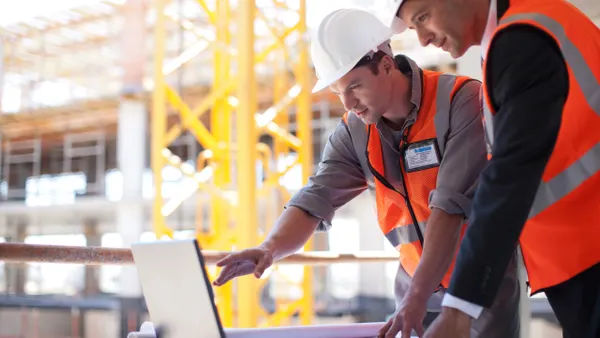Danielle O’Connell doesn’t want to have tunnel vision on one safety solution.
O’Connell, senior director of Skanska USA’s emerging technology team, has seen tech-based safety methods come and go. Now, however, she said data is king, and the future is bright.
Here, O’Connell talks with Construction Dive about the state of safety tech, how it has evolved and where it’s headed.
Editor’s Note: This interview has been edited for brevity and clarity.
CONSTRUCTION DIVE: Where are we with the current state of safety technology?
DANIELLE O’CONNELL: It has certainly come a long way. I've been in the industry for about 15 years, and I've seen it start to really incorporate artificial intelligence, data and 360-degree photography. The focus has also changed to look at leading indicators versus lagging indicators, and really thinking about that.
The way that we're planning our projects is leaps and bounds ahead of where it was when I first started in the industry.
What’s at the top of the safety tech stack today?
Everything we do is driven by data.
Today, we have standards around the data we're collecting, through Procore but also with 360-degree cameras. That was not a thing that existed 15 years ago, but it's a thing over the past five years that we've really adopted.
There's a lot of cutting-edge technology that we're able to leverage, like computer vision, which derives meaningful information from images that we can act on.
We take a look at data that was captured throughout the day, week, month and year and analyze what happened, which are the lagging indicators, but can also predict what might happen in the future.
What piece of safety technology excites you the most?
How robotics can help us collect data and think about layout, I think that's really exciting.
We've had a few pilots with some layout robotics. It takes the burden off of the drywall subcontractor, for example, who was actually bending over and snapping the line repeatedly on the job.
I think about how things like that could really save a person's back, not to mention their sanity and improving their mental health. There's so much that I think could impact that.
How does data interact with safety on a jobsite?
Everything we do, every technology we use, every sensor that we use, has some data associated with it.
We can use 360-degree cameras, for example, to collect data points and capture a moment in time. We then lay tools like computer vision over that data to analyze potential risks on our jobsites.
Wearables are another example. Our workers are actually being monitored along with our equipment to ensure they don’t encounter each other in an unsafe way.
What’s still needed for construction technology and safety?
I think we need to see more technology around leading indicators and being able to do what we can do with data to look ahead.
More automation and lessons learned, and how can we take lagging indicators on a past project and incorporate them into the planning for our next project.
So, making sure we have a plan in place that identifies pinch points across our project sites and then making sure we have the tools in place to avoid those risks.
From a leading indicators perspective, we're looking ahead to what might happen. Those lessons learned the day before or the year before on a similar project can lead to better decisions and risk avoidance.
I wish we could predict the future, and maybe we can at some point. But I'm not sure we’re there just yet.



















